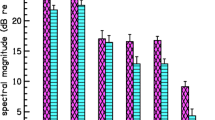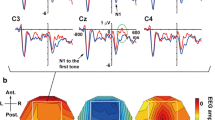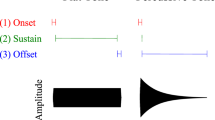Summary
This study examined the time course of attentional tuning of the N1 and P3 components of the auditory evoked potential. Human subjects were presented with two concurrent sequences of pure tone stimuli, one sequence delivered to each ear. They were instructed to listen to the tones in one ear and count randomly-embedded target stimuli, identified by pitch, while ignoring concurrent and physically equivalent stimuli in the other ear. Attention was then allocated to other ear-pitch combinations in subsequent runs. The rate of stimulation was rapid, an average of three stimuli per second per channel, to maximize N1 differences between channels. Evoked potentials were sampled at various times during each experimental run, to determine the time course of amplitude change in each auditory channel, as the subject tuned his neural response to the selected stimuli.
The results indicated that N1 took 30–45 s to emerge as significantly larger in the attended channel, whereas P3 was instantly larger in the attended channel upon presenting the first rare stimulus of a run. The N1 effect disappeared for standard stimuli after about 7 min of stimulation, despite a continuously high rate of target identification. However, for the rare target stimuli, N1 and P3 remained at a higher level in the attended channel throughout the typical 15 min run. The study concludes that neural selectivity proceeds in a “top-down” manner, with the longer-latency P3 component showing a selective response sooner than N1. In addition, there is evidency that the selectivity of N1 tuning increases over time, with the continued focussing of attention.
Similar content being viewed by others
References
Axelrod S, Guzy LT, Diamond IT (1968) Perceived rate of monotic and dichotically presented clicks. J Acoust Soc Am 43: 51–55
Broadbent DE (1958) Perception and communication. Pergamon Press London
Broadbent DE, Gregory R (1964) Stimulus set and response set: The alternation of attention. QJ Exp Psychol 16: 309–312
Broekhoven LH, Brooker BH, Czigler M, Donald MW (1981) Maximum likelihood estimation of the accuracy of discrimination performance in the absence of an overt response to every stimulus. Unpubl. manuscript, Queen's University, Canada
Courchesne E, Hillyard SA, Galambos R (1975) Stimulus novelty, task relevance and the visual evoked potential in man. Electroencephalogr Clin Neurophysiol 39: 131–143
Davis H, Mast T, Yoshie N, Zerlin S (1966) The slow response of the human cortex to auditory stimuli: Recovery process. Electroencephalogr Clin Neurophysiol 21: 105–113
Desmedt JE, Robertson D (1977) Differential enhancement of the cortical somatosensory evoked potential during forced-paced cognitive tasks in man. J Physiol (Lond) 271: 761–782
Donald MW, Little R (1981) The analysis of stimulus probability inside and outside of the focus of attention, as reflected by the auditory N1 and P3 components. Can J Psychol 35: 101–113
Donald MW, Young MJ (1980) Habituation and rate decrements in the auditory vertex potential during selective listening. In: Kornhuber HH, Deecke L (eds) Motivation, motor and sensory processes of the brain. Biomedical Press, Elsevier/North Holland (Progress in brain research, vol 54, pp 331–336)
Frühstorfer K, Bergström RM (1969) Human vigilance and auditory evoked responses. Electroencephalogr Clin Neurophysiol 27: 346–355
Groves PM, Thompson RF (1970) Habituation: A dual-process theory. Psychol Rev 77: 419–450
Harter MR, Previc FH (1978) Size-specific information channels and selective attention: Visual evoked potential and behavioral measures. Electroencephalogr Clin Neurophysiol 45: 628–640
Harvey N, Treisman AM (1973) Switching attention between the ears to monitor tones. Percept Psychophysiol 14: 51–59
Hillyard SA (1981) Selective auditory attention and early eventrelated potentials: A rejoinder. Can J Psychol 35: 85–100
Hillyard SA, Picton TW (1979) Event-related brain potentials and selective information processing in man. In: Desmedt JE (ed) Progress in clinical neurophysiology, vol VI. Karger, Basel, pp 1–52
Hillyard SA, Hink RF, Schwent VI, Picton TW (1973) Electrical signs of attention in the human brain. Science 182: 177–180
Megela A, Teyler TJ (1979) Habituation and the human evoked potential. J Comp Physiol Psychol 93: 1154–1170
Moray N (1969) Attention: Selective processes in vision and hearing. Hutchinson, London
Näätänen R, Michie PT (1979) Early selective-attention effects on the evoked potentials: A critical review and reinterpretation. Biol Psychol 8: 81–136
Ritter W, Vaughan HG, Costa LD (1968) Orienting and habituation to auditory stimuli: A study of short-term changes in average evoked responses. Electroencephalogr Clin Neurophysiol 25: 550–556
Schwent VL, Hillyard SA (1975) Evoked potential correlates of selective attention with multichannel auditory inputs. Electroencephalogr Clin Neurophysiol 38: 131–138
Squires NK, Squires KC, Hillyard SA (1975) Two varieties of long-latency positive waves evoked by unpredictable auditory stimuli in man. Electroencephalogr Clin Neurophysiol 38: 387–401
Treisman AM (1971) Shifting attention between the ears to monitor tones. Q J Exp Psychol 23: 157–167
Author information
Authors and Affiliations
Additional information
Funded by the National Science and Engineering Research Council of Canada
Rights and permissions
About this article
Cite this article
Donald, M.W., Young, M.J. A time-course analysis of attentional tuning of the auditory evoked response. Exp Brain Res 46, 357–367 (1982). https://doi.org/10.1007/BF00238630
Received:
Published:
Issue Date:
DOI: https://doi.org/10.1007/BF00238630




